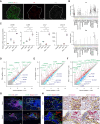Tertiary Lymphoid Tissues Are Microenvironments with Intensive Interactions between Immune Cells and Proinflammatory Parenchymal Cells in Aged Kidneys
- PMID: 37548710
- PMCID: PMC10561819
- DOI: 10.1681/ASN.0000000000000202
Tertiary Lymphoid Tissues Are Microenvironments with Intensive Interactions between Immune Cells and Proinflammatory Parenchymal Cells in Aged Kidneys
Abstract
Significance statement: Ectopic lymphoid structures called tertiary lymphoid tissues (TLTs) develop in several kidney diseases and are associated with poor renal prognosis. However, the mechanisms underlying TLT expansion and their effect on renal regeneration remain unclear. The authors report that single-nucleus RNA sequencing and validation experiments demonstrate that TLTs potentially amplify inflammation in aged injured kidneys. Lymphocytes within TLTs promote proinflammatory phenotypes of the surrounding proximal tubules and fibroblasts within the TLTs via proinflammatory cytokine production. These proinflammatory parenchymal cells then interact with immune cells by chemokine or cytokine production. Such cell-cell interactions potentially increase inflammation, expand TLTs, and exacerbate kidney injury. These findings help illuminate renal TLT pathology and suggest potential therapeutic targets.
Background: Ectopic lymphoid structures called tertiary lymphoid tissues (TLTs) develop in several kidney diseases and are associated with poor renal prognosis. However, the mechanisms that expand TLTs and underlie exacerbation of kidney injury remain unclear.
Methods: We performed single-nucleus RNA sequencing (snRNA-seq) on aged mouse kidneys with TLTs after ischemia-reperfusion injury. The results were validated using immunostaining, in situ hybridization of murine and human kidneys, and in vitro experiments.
Results: Using snRNA-seq, we identified proinflammatory and profibrotic Vcam1+ injured proximal tubules (PTs) with NF κ B and IFN-inducible transcription factor activation. VCAM1 + PTs were preferentially localized around TLTs and drove inflammation and fibrosis via the production of multiple chemokines or cytokines. Lymphocytes within TLTs expressed Tnf and Ifng at high levels, which synergistically upregulated VCAM1 and chemokine expression in cultured PT cells. In addition, snRNA-seq also identified proinflammatory and profibrotic fibroblasts, which resided within and outside TLTs, respectively. Proinflammatory fibroblasts exhibited STAT1 activation and various chemokine or cytokine production, including CXCL9/CXCL10 and B cell-activating factor, contributing to lymphocyte recruitment and survival. IFN γ upregulated the expression of these molecules in cultured fibroblasts in a STAT1-dependent manner, indicating potential bidirectional interactions between IFN γ -producing CXCR3 + T cells and proinflammatory fibroblasts within TLTs. The cellular and molecular components described in this study were confirmed in human kidneys with TLTs.
Conclusions: These findings suggest that TLTs potentially amplify inflammation by providing a microenvironment that allows intense interactions between renal parenchymal and immune cells. These interactions may serve as novel therapeutic targets in kidney diseases involving TLT formation.
Copyright © 2023 The Author. Published by Wolters Kluwer Health, Inc. on behalf of the American Society of Nephrology.
Conflict of interest statement
T. Kobayashi reports Consultancy: Astellas Pharma, Janssen Pharma; Research Funding: Astellas Pharma, Chugai Pharmaceutical, MSD; and Honoraria: Astellas Pharma, Bayer, Janssen Pharma, and MSD. Y. Murakawa reports the following: Employer: RIKEN; Ownership Interest: Revorf; and Research Funding: K.K. DNAFORM, and Revorf. Y. Sato reports Employer: Mitsubishi Tanabe Pharmaceutical company. M. Yanagita received research grants from Boehringer Ingelheim and Mitsubishi Tanabe Pharma. M. Yanagita also reports Honoraria: Astellas, Chugai, Kyowa Kirin, and others for lecture honoraria; and Speakers Bureau: AstraZeneca, Astellas, Kyowa Kirin, and others for lecture honoraria. T. Yoshikawa reports Honoraria: Kyowa Kirin. All remaining authors have nothing to disclose.
Figures









Comment in
-
Close Encounters of the Tertiary Kind: Intercellular Inflammatory Communication Long after AKI.J Am Soc Nephrol. 2023 Oct 1;34(10):1603-1604. doi: 10.1681/ASN.0000000000000216. J Am Soc Nephrol. 2023. PMID: 37782545 Free PMC article. No abstract available.
References
Publication types
MeSH terms
Substances
LinkOut - more resources
Full Text Sources
Research Materials
Miscellaneous

